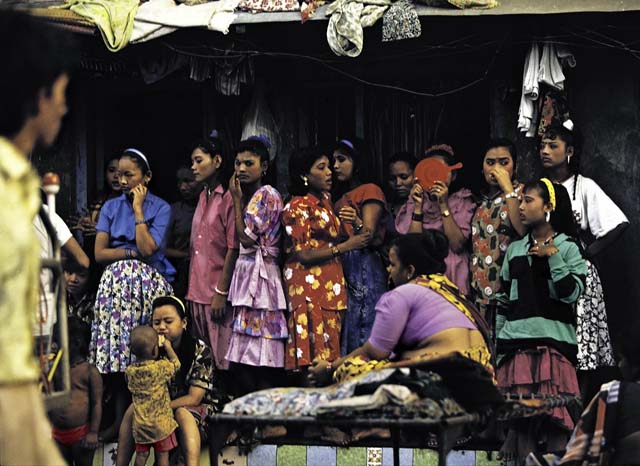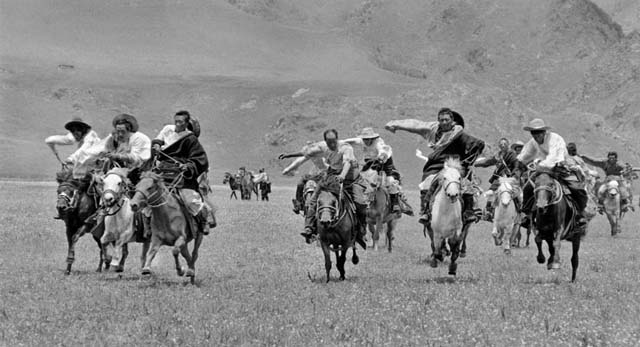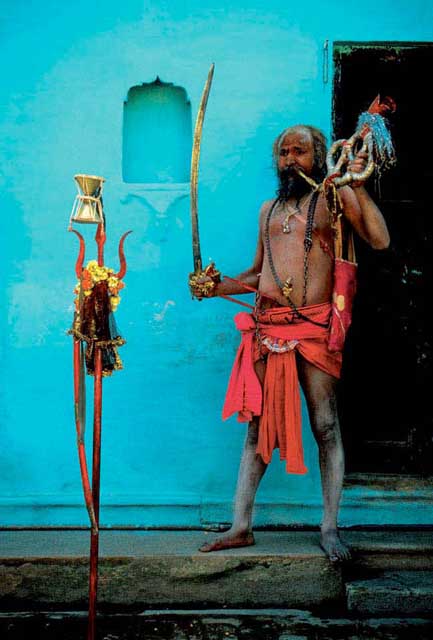Sadhus and Sex Workers
“My entertainment is sitting down with these people and recording their stories and learning from them,” he says. His travels have vicariously taken many others to far off worlds through his powerful images in several books including The Hidden Himalayas; Sacred Landscape-Pilgrimage in Tibet; In Search of the Lost Kingdom of Bon; Fallen Angels: Sex Workers of South Asia; Tibet: Reflections from the Wheel of Life; and Kathmandu: City on the Edge of the World.
Each of these books has been like a tapasya for him, going deep into the culture, be it Shamanism, the sadhus or the sex-workers. His photography of the Kumbh Mela shows the robustness of the sadhu tradition, and also makes for powerful images – especially of the Naga sadhus.

Perhaps some of the most poignant testimony of a culture in flux is his ethnographic work of marginalized, landless communities. He has lived with the Badi people where the young women have had to sell themselves to keep their families out of poverty. Once they were singers and dancers and entertainers at weddings and other ceremonies – now these women have to use their bodies as a source of income.
Using a Gates grant, Kelly looked into the lives of fallen angels in various parts of Asia, from ‘maalish’ or massage boys in hotels to sex worker communities, analyzing what drove them to this work and how they could be helped by the organizations.
Besides handling communications and a photo service company, Kelly has produced and directed films and videos on prostitution, violence against women, and esoteric ethnic practices for Discovery Communications, USA, National Geographic, and the BBC. It’s all about creating awareness of the travails of this little known part of the world.
Kelly has been the technical advisor for The Youth Expression Project, YEP, a program to help young people handle peer pressure, parental issues, drug abuse, sexual abuse and the conflicts of modern versus traditional through the use of media. Says Kelly, “This project is about aiding them to understand their problems, concerns, hopes, fears, frustrations, and teaching them how to use media – writing, photography, video – to express those concerns on a public platform.”
His wife Carroll is just as engaged with the community. A Princeton University anthropologist, writer, documentary film maker, yoga instructor, she is the founder of Wild Earth (www.wildearthnepal.com), a cooperative producing Himalayan herbal products, as well as products by local craftspeople. She and Kelly have two boys, Liam, 14 and Galen, 11.
While there’s a whole tradition of armchair travelers who have seen these far-off places and people through Kelly’s photography books and videos, he wants everyone to see them in the flesh and blood, to experience them in real life. Knowing the reluctance of people to travel to unknown places, Kelly and his family offer to take you on tours from Mongolia to Nepal. You can get more details at www.wildearthjourneys.com. Many of these are in conjunction with National Geographic. They take you on pilgrimages and retreats through this fascinating terrain.

While Nepal has become home for Kelly and his family, he wanders out to the west once in a while, to the world he left behind. Some people may wonder how Kelly could leave the trappings and material pleasures of the west to live in a very different and more rudimentary world, but this is what gives him the most pleasure. He draws from the wisdom of the sadhus, many of whom he has got to know over the years. He was recently in New York at the Rubin Museum of Art for a stunning exhibit of ‘Sadhus: Body Markings’ and was introduced by his twin brother, the artist Robert Kelly who every day wakes up to a very different city – New York.
As Robert says, he’s lived vicariously – like so many of us – through the adventures of his wandering brother. He calls Thomas the ‘perpetual pilgrim’ and says, “Thomas has really collapsed the cultural paradigm between the self and the other. His backyard is very much inhabited by the characters he’s photographed in the book. So he really does inhabit that world – he is a Nepali.”
Thomas Kelly, once an altar boy, now finds many answers in the Hindu-Buddhist way of life, such as how to view the world as impermanent, live in the present and look inward, not outward. An avid yogi, he begins each day with asanas and meditation. “A chance to reflect on the preciousness of human existence is something I value,” he says.
Ask Kelly if he was perhaps a Nepalese in his last life and he laughs: “Maybe I was a bit of a wandering sadhu and I had a skill that I could offer to many people. I analyze and try to understand a situation instead of relying on others. Being an observer – which camera work has taught me to be – is fascinating.”
What gets him through good times and bad? “Staying positive,” says the Perpetual Pilgrim. “When negative energy comes up I try to analyze what the root cause is and if I can’t figure it out then I ask the masters who have a philosophical looking glass into it – after all, we all need help and friendship.”
© Lavina Melwani
(This article first appeared in Housecalls)

Body Language: The Yogis of India and Nepal
The enigmatic world of sadhus, the vividly decorated or completely nude ascetics of Hinduism, was explored in Body Language: The Yogis of India and Nepal at the Rubin Museum of Art this winter. Striking photographs by Thomas L. Kelly capture extraordinary-looking male sadhus (as well as a female sadhvi), famously known as the mystics, ascetics, yogis and wandering monks of South Asia. Sadhus renounce worldly life, earthly possessions and social obligations to devote their lives entirely to religious practice and the quest for spiritual enlightenment.
Sadhus, whom Kelly describes as “disturbing, annoying, inspiring, exasperating, irrational, wise and powerful,” increase their spiritual powers and advance on their path to enlightenment by practicing intensive forms of yoga and meditation and even performing magic rituals. They use their body like a canvas on which to tell stories, using colors and symbols to represent esoteric inner visions and higher states of consciousness, while also expressing their religious identities.
– Source: The Rubin Museum of Art, New York
All photos (C) Thomas Kelly
Related Article:
Thomas Kelly and The Sadhu Universe
What do you think? Which image gets your vote?

10 Comments
Tapas, thank you for your comment. I love the term ‘armchair pilgrim’! We have to be grateful to Thomas Kelly for his evocative images which take us to people and places we may never see.
Thanks Lavina for the post. Thomas Kelly is a rare ‘speed-breaker’ on the whirlwind tour of an armchair pilgrim like me. His work makes one pause and ponder about life.
John, thank you for your comments. Tom has indeed had a fascinating life – several lives actually! Tibet and Nepal in the 70’s and 80’s must have been a very special experience and I’m sure the effects of that are with you still.
On Lassi with Lavina I do try to capture all the nuances of east and west, and would certainly love to hear of different experiences. Please feel free to share with us.
Thanks, David for your comment. I have also emailed it to Thomas Kelly.
Great to read about Tom’s story… how he landed, his early days, and how it all evolved and grew in him.
Those of us lucky enough to find ourselves in Nepal and Tibet in the 70’s and 80’s were lucky indeed… or WAS it karma? Kathmandu has always been a crossroads… to be among the Sadhus, Rinpoches, Newaris, and all the other “east meets westerners” who gathered and still gather there is an incredible confluence of hearts, minds, and souls. We were all pilgrims, and it continues to ripen within us. Thanks, Lavina for posting this and to Tom for living it and sharing it all with his photography and compassionate activism.
A comment for Thomas Kelly.
It’s been a long time. I follow your site and your books with a great deal of nostalgia. You’re a pleasure to follow and a great connection to my “past”. I’ve continued in emergency medicine after returning to the US and am about to retire to our home in Moose, Wyoming in two months. Stay in touch. Best wishes, David
Kriti, thanks for your comments. Yes, Thomas Kelly is still a wandering sadhu, telling the stories with his camera! I’d done an earlier piece on his images of sadhus, and that’s powerful stuff.
Thanks, AK Sandhu, inspiring it certainly is. If you take a look at Thomas Kelly’s website you are really struck by the sheer range of his work, and the different lives he captures.
A very intriguing post indeed. The pictures tell so many stories at once. I love the part where the prophecy says that Thomas was still a sadhu of a different kind. Kind of awakened something in me. Loved being here.
Thank you for sharing such inspiring work!